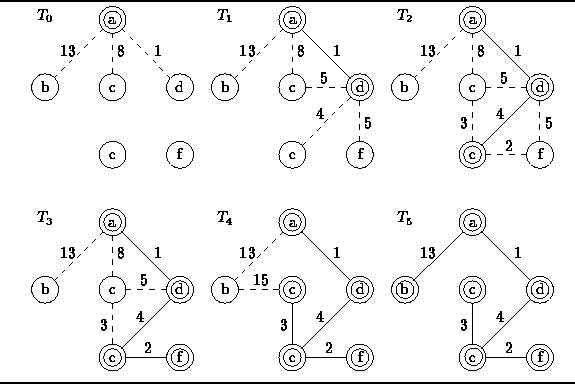Prim's algorithm
finds a minimum-cost spanning tree
of an edge-weighted, connected, undirected graph ![]() .
The algorithm constructs the minimum-cost spanning tree of a graph
by selecting edges from the graph one-by-one
and adding those edges to the spanning tree.
.
The algorithm constructs the minimum-cost spanning tree of a graph
by selecting edges from the graph one-by-one
and adding those edges to the spanning tree.
Prim's algorithm is essentially
a minor variation of Dijkstra's algorithm
(see Section ![]() ).
To construct the spanning tree,
the algorithm constructs a sequence of spanning trees
).
To construct the spanning tree,
the algorithm constructs a sequence of spanning trees
![]() ,
each of which is a subgraph of G.
The algorithm begins with a tree that contains
one selected vertex, say
,
each of which is a subgraph of G.
The algorithm begins with a tree that contains
one selected vertex, say ![]() .
That is,
.
That is, ![]() .
.
Given ![]() ,
we obtain the next tree in the sequence as follows.
Consider the set of edges given by
,
we obtain the next tree in the sequence as follows.
Consider the set of edges given by
![]()
The set ![]() contains all the edges
contains all the edges ![]() such that exactly one of v or w is in
such that exactly one of v or w is in ![]() (but not both).
Select the edge
(but not both).
Select the edge ![]() with the smallest edge weight,
with the smallest edge weight,
![]()
Then ![]() ,
where
,
where ![]() and
and ![]() .
After
.
After ![]() such steps we get
such steps we get ![]() which is the minimum-cost spanning tree of G.
which is the minimum-cost spanning tree of G.
Figure ![]() illustrates how Prim's algorithm determines
the minimum-cost spanning tree of the graph
illustrates how Prim's algorithm determines
the minimum-cost spanning tree of the graph ![]() shown in Figure
shown in Figure ![]() .
The circled vertices are the elements of
.
The circled vertices are the elements of ![]() ,
the solid edges represent the elements of
,
the solid edges represent the elements of ![]() and the dashed edges represent the elements of
and the dashed edges represent the elements of ![]() .
.

Figure: Operation of Prim's algorithm.